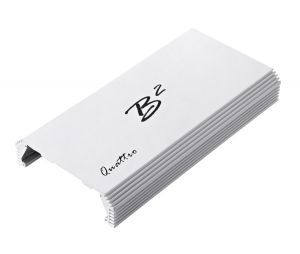
1. Misunderstanding analysis of LED heat dissipation
The misunderstanding of LED heat dissipation is mainly reflected in the following aspects:
1. The internal quantum efficiency is not high. That is, when electrons and holes are recombined, they cannot produce 100% photons. It is usually called "current leakage" which reduces the recombination rate of carriers in the PN region. The leakage current multiplied by the voltage is the power of this part, which is converted into heat energy, but this part does not account for the main component, because the internal photon efficiency is now close to 90%.
2. The photons generated inside cannot be emitted to the outside of the chip and finally converted into heat. This part is the main one, because the current so-called external quantum efficiency is only about 30%, and most of it is converted into heat.
3. Excessive reliance on thermally conductive materials. Because what high-tech materials are used can dissipate the heat. Its practical common aluminum heat dissipation, after many tests, the temperature of the heat sink is only 3-5 degrees Celsius higher than the bottom of the radiator. In other words, if a material with excellent thermal conductivity can be used, the temperature can be reduced by 3-5 degrees Celsius when the thermal resistance is zero.
4. Superstition in heat pipes. There is no doubt that heat pipes have good thermal conductivity. But the heat derived from the heat sink eventually needs to be transported away by air convection. If there are no fins for heat dissipation, the heat pipe will quickly reach thermal equilibrium and the temperature will rise together with the heat sink. However, if fins are added to the heat pipe, fins will eventually be used for heat dissipation. Moreover, the contact point between the fin and the heat pipe is not as good as other methods. As a result, the cost is high, and the heat dissipation effect is not improved. However, it is still useful for heat pipes to conduct heat on integrated LEDs, but they must have a reasonable structure!
5. Believe in the nano-radiation materials promoted by some manufacturers. The proportion of radiant heat dissipation can be ignored when the current LED lamp temperature is about 50 degrees Celsius. And even if the radiation coating advertised by the manufacturer has a good radiation effect as they advertise, even if it reaches the radiation capacity of black body radiation, its heat dissipation proportion is only a few percent. Moreover, the coating itself will hinder the conduction of heat, thereby affecting the heat dissipation of convection.
2. Solutions to LED heat dissipation problems
Let's break down the solutions to the LED heat dissipation problem.
1, aluminum fins
This is the most common way to dissipate heat. Aluminum fins are used as part of the shell to increase the heat dissipation area.
2, thermally conductive plastic shell
The use of LED insulation and heat dissipation plastic instead of aluminum alloy to make the heat sink can greatly improve the heat radiation ability.
3, air fluid mechanics
Using the shape of the lamp housing to create convective air, this is the lowest cost way to enhance heat dissipation.
4, liquid bulb
Using liquid bulb encapsulation technology, a transparent liquid with high thermal conductivity is filled into the bulb of the lamp body. This is the only technology that uses the light emitting surface of the LED chip to conduct heat and dissipate heat in addition to the principle of light reflection.
5. Use of lamp holder
In household-type low-power LED lamps, the internal space of the lamp holder is often used to partially or completely insert the heating drive circuit. In this way, a lamp cap with a larger metal surface such as a screw cap can be used to dissipate heat, because the lamp cap is closely connected to the metal electrode of the lamp holder and the power cord. Therefore, a part of the heat can be radiated from this.
6, insulation and heat dissipation plastics replace aluminum alloy
Insulating and heat-dissipating plastics replace aluminum alloys to make heat sinks. This kind of LED insulating and heat-dissipating plastics can increase the heat radiation capacity by 4-8 times while keeping the heat dissipation capacity equal to the aluminum alloy. The LED heat sink made of this heat dissipation material can greatly improve the overall heat dissipation effect.
7. Integration of heat and heat dissipation-the application of high thermal conductivity ceramics
The purpose of the heat dissipation of the lamp housing is to reduce the working temperature of the LED chip. Since the expansion coefficient of the LED chip is very different from the expansion coefficient of our commonly used metal heat conduction and heat dissipation materials, the LED chip cannot be directly welded to avoid high and low temperature thermal stress to damage the LED chip. The latest high thermal conductivity ceramic material, the thermal conductivity is close to aluminum, and the expansion system can be adjusted to synchronize with the LED chip. In this way, heat conduction and heat dissipation can be integrated, reducing the intermediate links of heat conduction.